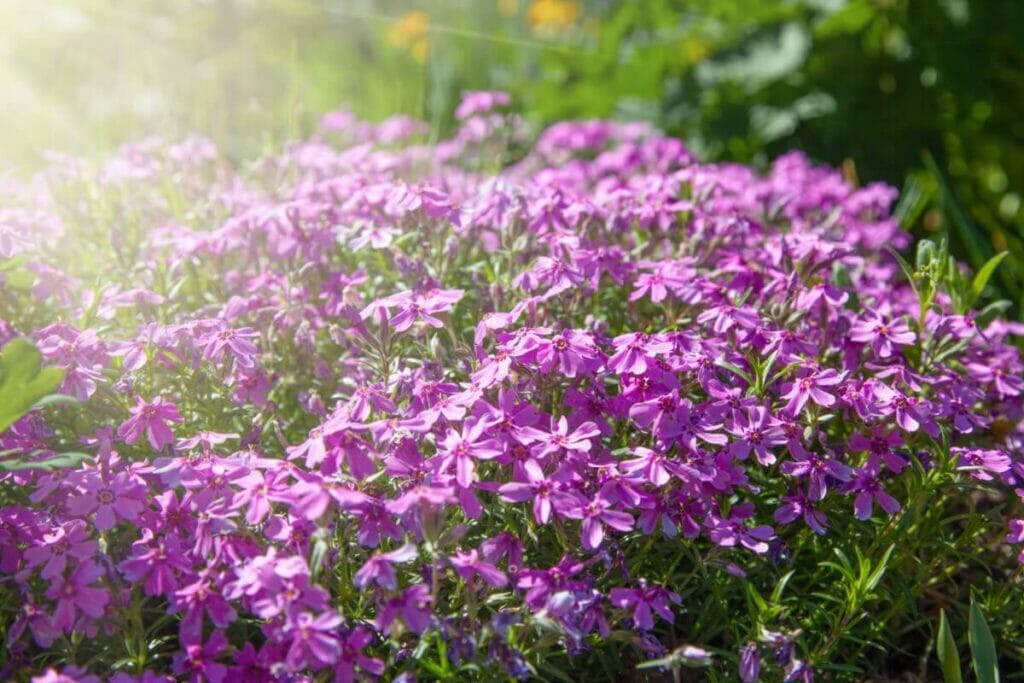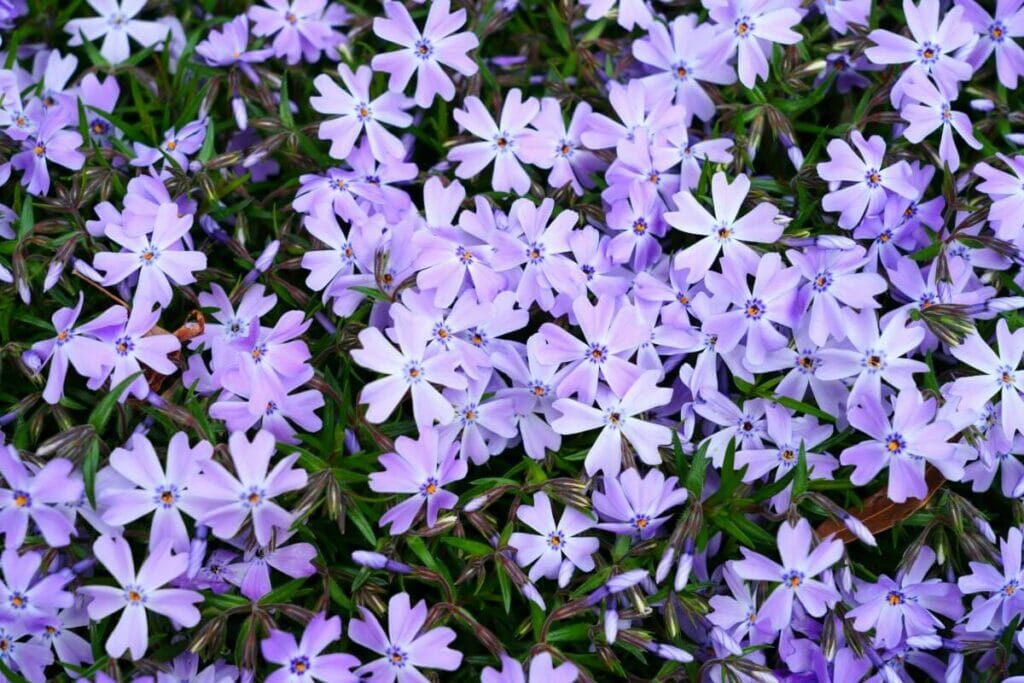How to Grow Phlox Subulata (Creeping Phlox) in Your Garden
Phlox subulata, most commonly called creeping phlox, makes a stunning addition to any garden or yard. With their spreading nature, you can plant a few creeping phlox plants, provide them with proper care, and then watch, year after year, as the perennial plants slowly take over your yard, creating a carpet of vibrant color. Here, we’ll take you through everything you need to know about growing Phlox subulata flowers at home, including planting, soil considerations, watering, fertilizing, pruning, propagating, and pest control.

Key Takeaways:
| Botanical Name: | Phlox subulata |
| Also Known As: | Creeping phlox, moss phlox, mountain phlox, or moss pink |
| Hardiness Zones: | 4 to 9 |
| Flowering Months: | March through May |
| Growing Difficulty: | Easy to grow in the right conditions. Requires some moderate maintenance. |
| Type of Plant: | Herbaceous, evergreen, spreading perennial |
| Light Requirements: | Full sun or bright, direct light. Prefers partial shade in areas with scorching summers. |
| Temp & Humidity: | It produces flowers at around 60°F, enters dormancy at 35°F to 44°F, and tolerates winter temperatures down to -20°F. It prefers low to moderate humidity. |
| Watering Needs: | During the spring and summer, water when rainfall is less than 1″ per week. Use a soaker hose to avoid wetting the plant’s leaves and thoroughly soak the soil. Allow the soil to dry completely before watering again. |
| Soil Preferences: | Well-draining and slightly acidic to neutral soil (pH 5 to 8) |
| Feeding: | In the garden, apply a slow-release, balanced fertilizer in late winter or spring. In containers, fertilize once in early spring and again in summer with a balanced, water-soluble fertilizer or slow-release fertilizer pellets. |
| Growth Expectations: | Mature plants achieve a 1 to 2-foot spread and are about 3 to 6 inches tall. |
| Toxicity: | Non-toxic to humans and pets |
How to Grow Phlox Subulata

Best Location for Planting
For the best blooms, plant creeping phlox in a spot that receives lots of bright, direct sunlight. In climates where springs and summers are particularly hot, a bit of dappled shade is okay.
In addition to boarders, beds, cottage gardens, rock gardens, and containers, they’re perfect plants for any place you’d like a colorful ground cover.
Best Time to Plant
Plant Phlox subulata in spring after the danger of the last frost of winter has passed.
Growing From Seed vs. Nursery Plants

Growing creeping phlox from seeds requires a very long process that can take up to two or three years until the plants are ready to be transplanted into the ground.
If you want a garden that looks stunning this year and even better next, it’s best to purchase young creeping phlox plants from a nursery to transplant into your garden.
What to Do Before Planting
Before planting, scope out a good location for your creeping phlox in your garden. Consider your space and the size of mature Phlox subulata plants before deciding how many plants you will need.
Be sure you have a hand shovel or trowel, slow-release fertilizer pellets or organic compost, and sand or perlite if your soil retains lots of moisture.
Best Soil Types
Creeping phlox is prone to root rot and fungus in overly moist soil. The best potting soil for Phlox subulata is rich and well-draining soil that contains sand, bark, or perlite.
Creeping phlox thrives in mildly acidic to neutral soil with a pH ranging from 5 to 8.
How to Plant
If planting in a container, choose one that is well-draining and about 2 to 4 inches larger than your plant.
To plant creeping phlox in the ground, find a spot 1 to 2 feet in diameter and dig a hole that is deep and large enough to accommodate the plant’s entire root ball. When placed in the hole, the top of the root ball should be in line with the top of the ground (or the top of the soil level in a container).
Create an ideal environment for your creeping phlox by ensuring the soil immediately surrounding the plant is well-draining and rich by mixing potting soil, mulch, and sand or perlite. You can also add balanced, slow-release fertilizer pellets to the mixture.
Light Preferences

Creeping phlox thrives in bright, direct sunlight. In full sun, these plants will produce the most beautiful flowers.
In particularly hot climates, creeping phlox can still grow beautifully in partial shade that will protect them from the hottest part of the day.
Temperature and Humidity
Creeping phlox does not fare well in high humidity and overly moist conditions. These plants are slightly drought tolerant and prefer low to moderate humidity.
Phlox subulata blooms at average temperatures of about 60°F. These plants enter dormancy between 35°F and 44°F, and they can survive winter temperatures down to -20°F.
How to Care for Phlox Subulata

Watering
Water creeping phlox in the spring and summer when weekly rainfall averages less than 1 inch.
To water, use a soaker hose or watering can that will allow you to apply water directly to the soil, avoiding the plant’s leaves, if possible. Water until the soil is thoroughly moist and saturated. Then, allow the soil to dry completely before watering again.
Fertilizing
Fertilizer gives plants the nutrients they need to grow and create beautiful flower blossoms.
While creeping phlox plants growing in the ground will usually do well without regular fertilizing, you can apply compost or mulch at the end of the season or in early spring to create a more rich environment.
If growing in containers, fertilize in the spring and again in the summer with a balanced, water-soluble fertilizer or mix in slow-release fertilizer pellets at the time of potting.
Pruning and Cutting Back

Creeping phlox should be pruned and cut back to control growth, maintain shape, and encourage healthy growth the following year.
You can either cut back stems immediately after blossoms are spent to prevent the spreading of seeds or you can wait until the fall. When cutting back creeping phlox in fall, trim back 1/2 the length of the stems or almost to the ground.
This protects the plant during winter and encourages new growth in spring.
Propagating
Phlox subulata is self-propagating in that they spread seeds after blossoming. However, you can propagate the plants yourself via root division.
To propagate a creeping phlox, simply dig up the plant’s root ball in the early spring, break or cut it into two halves (you can use sterile pruning shears for a clean cut), and replant each half separately.
Overwintering

To overwinter creeping phlox, prune back the stems in late summer or early fall.
Creeping phlox can survive the winter without any special care in growing zones 4 to 9. If you live in zone 4 or lower, protect your plants’ roots by spreading a layer of mulch over the plants.
Repotting
Creeping phlox growing in a container must be divided and repotted every 2 to 4 years. The best time to do this is in the early spring or fall.
To start, gently tease your plant loose from its container and remove it. Loosen as much soil as you can from the plant’s root ball. If separating, divide the plant into two equal portions. One can return to the original pot, and you can plant the other in another well-draining pot of a similar size.
Common Problems and How to Fix Them

Signs of Problems:
- Powdery Substance on Plants – This is a sign of mildew fungus growing. It can affect plants that are overly moist or don’t have proper air circulation. Reduce watering frequency. Wash leaves with a solution of baking soda, mild liquid soap, and water.
- Few or No Flowers – Creeping phlox needs at least 6 hours of full sun daily to bloom properly. Mildew can also stunt flowers.
- Drooping Leaves – Usually occurs due to overwatering. Check soil drainage and reduce watering frequency.
- Wilted or Crisp Foliage – This is a sign of not enough moisture. Although creeping phlox is somewhat drought-tolerant, they prefer evenly moist soil. Increase your watering frequency.
Pests and Diseases:
- Spider Mites – The underside of leaves will have a bronzed, yellowed, or speckled appearance. Treat leaves with horticultural oil or spider mite pesticide.
- Phlox Bugs – Curled and yellowed leaves indicate the presence of phlox bugs. Treat plants with horticultural soap or oil and clean up plant debris throughout the year.
- Foliar Nematodes – Signs of these worms include distorted growth and oddly shaped leaves and stems. Treat plants with a specially formulated pesticide solution.
Essential Tools for Growing Creeping Phlox
- Moisture meter or soil probe
- Watering can
- Soaker hose
- Cutting shears or secateurs
- Balanced slow-release fertilizer pellets and/or water-soluble liquid fertilizer
- Sand or perlite
A Carpet of Color for Spring
Creeping phlox makes a wonderful addition to any garden. With their spreading habit and a teeny bit of effort from you, just a few plants can create a veritable carpet of color in your yard after only a few years!
Andrew is the Editorial Director at Petal Republic. He holds a BSc degree in Plant Sciences and has trained professionally at leading floristry schools in London and Paris. In amongst overseeing a global editorial team, Andrew's a passionate content creator around all things flowers, floral design, gardening, and houseplants.
